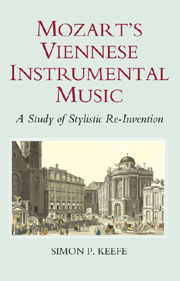Book contents
- Frontmatter
- Contents
- List of Musical Examples
- List of Figures
- For Celia, Abraham and Madeleine
- Acknowledgements
- Introduction: Mozart and Stylistic Re-Invention
- I PIANO CONCERTOS
- 1 ‘An Entirely Special Manner’: Mozart's Piano Concerto No. 14 in E♭, K. 449, and the Stylistic Implications of Confrontation
- 2 On the Grand, Brilliant and Intimate: Mozart's Piano Concertos K. 450 – K. 503 (1784–86)
- 3 A Complementary Pair: Stylistic Experimentation in Mozart's Final Piano Concertos, No. 26 in D, K. 537 (the ‘Coronation’), and No. 27 in Bb, K. 595
- II STRING QUARTETS
- III SYMPHONIES
- IV CONCLUSIONS
- Bibliography
- Index of Mozart's Works by Köchel Number
- Index of Mozart's Works by Genre
- General Index
3 - A Complementary Pair: Stylistic Experimentation in Mozart's Final Piano Concertos, No. 26 in D, K. 537 (the ‘Coronation’), and No. 27 in Bb, K. 595
from I - PIANO CONCERTOS
Published online by Cambridge University Press: 05 September 2013
- Frontmatter
- Contents
- List of Musical Examples
- List of Figures
- For Celia, Abraham and Madeleine
- Acknowledgements
- Introduction: Mozart and Stylistic Re-Invention
- I PIANO CONCERTOS
- 1 ‘An Entirely Special Manner’: Mozart's Piano Concerto No. 14 in E♭, K. 449, and the Stylistic Implications of Confrontation
- 2 On the Grand, Brilliant and Intimate: Mozart's Piano Concertos K. 450 – K. 503 (1784–86)
- 3 A Complementary Pair: Stylistic Experimentation in Mozart's Final Piano Concertos, No. 26 in D, K. 537 (the ‘Coronation’), and No. 27 in Bb, K. 595
- II STRING QUARTETS
- III SYMPHONIES
- IV CONCLUSIONS
- Bibliography
- Index of Mozart's Works by Köchel Number
- Index of Mozart's Works by Genre
- General Index
Summary
WITH his Piano Concerto No. 25 in C, K. 503, completed in Vienna on 4 December 1786, Mozart brought an extraordinary sequence of Viennese concertos to a close. In the space of four years (1782–86) he had composed 15 masterworks, endearing himself to the Viennese public through acclaimed performances at the Burgtheater, Trattnerhof and Mehlgrube. Alongside his singspiel Die Entführung aus dem Serail (1782), his opera Le nozze di Figaro (1786), and his six string quartets dedicated to Haydn (K. 387, 421, 428, 458, 464, 465, published in 1785), these concertos established Mozart as a leading light on the Viennese musical scene.
In contrast to his prolific concerto production of 1782–86, Mozart completed only two more piano concertos between the end of 1786 and his death in 1791: No. 26 in D, K. 537, nicknamed the ‘Coronation’ on account of Mozart's performance of the work at the coronation festivities for Leopold II in Frankfurt on 15 October 1790, and No. 27 in Bb, K. 595. In spite of the success of the former on the nineteenth- and early twentieth-century concert stage, neither is among his most popular instrumental works, nor – with the notable exception of several commentaries on the latter – among his most critically acclaimed. In fact, no major instrumental work from Mozart's entire Viennese period has suffered comparable ignominy in the hands of commentators as K. 537.
- Type
- Chapter
- Information
- Mozart's Viennese Instrumental MusicA Study of Stylistic Re-Invention, pp. 64 - 86Publisher: Boydell & BrewerPrint publication year: 2007



